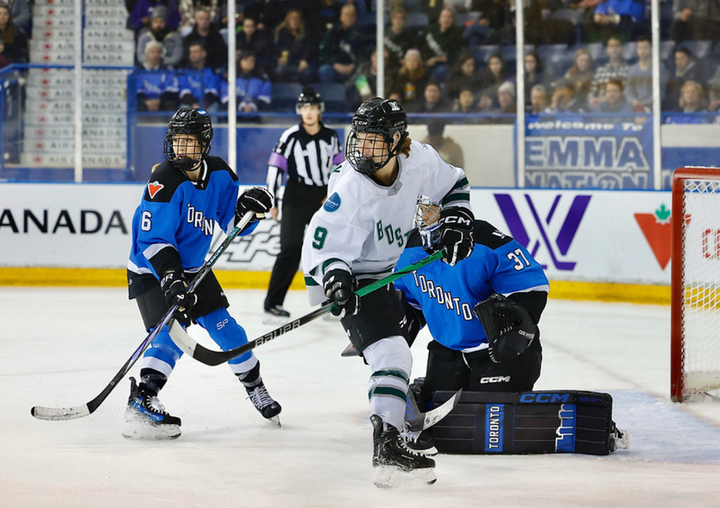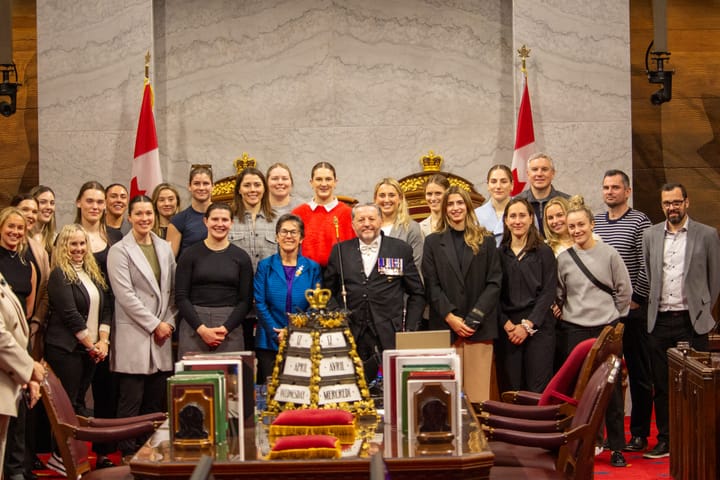#BeBoldForChange: Where does women’s hockey go from here?
A look at the unwavering unity of the national team and what it could mean for the game
The U.S women’s national team continues to sail on cloud nine after winning on and off the ice. The newest deal with USA Hockey is a shiny notch on the way to a better future for women’s hockey. However, there are more victories to be won. The positive momentum gained might have evaporated had the women failed to earn anything less than a perfect 5-0 en route to a fourth consecutive gold medal at the Women’s World Hockey Championships. As the latest hockey season comes to a close, there are a few things to important things to watch for in 2017-18.
The state of women’s hockey
Earlier in the 2016-17 hockey season, the NWHL announced salary cuts to its players. The day after hockey players celebrated the women’s national team, the University of North Dakota (UND) cut its top-10 ranked women’s hockey program. Both impacted current, former, and likely future USA Hockey players.
Eleven players on the World Championship team also competed in the second season of the NWHL. Additionally, eight players who competed in the 2017 world championships — including twin sisters Jocelyne Lamoureux-Davidson and Monique Lamoureux-Morando of Team USA — are alumnae of or current players for the UND women’s hockey program.
The victory of the national team makes both the NWHL and UND cuts more heartbreaking for players. In both instances, players were blindsided by the news. The cuts illuminate the severity of the issue of equality and equity for women in hockey. The issue women’s hockey faces is not limited to a lack of resources and a livable wage and compensation. There is also a lack of equal respect for women’s hockey.
Related
Who Do You Pay For: USA Hockey and the Undervaluing of Women Athletes
With much yet to accomplish in women’s hockey, can the women’s national team model be used by other players hoping to save their salaries, or their programs? Here is a look at how the women’s national team reached a deal, while simultaneously offering a blueprint to other women looking to fight for what they need to be supported and funded as elite athletes.
The details
For 13 days, the women’s hockey team engaged in a work stoppage; a strike. The strike itself was just the beginning — the women also initiated a social media campaign and what might be called a women’s hockey phone tree, literally. USA Hockey executives were unable to find a viable team of 15 players to represent the United States at the 2017 IIHF World Championships — on home ice, no less. USA Hockey was forced to call an emergency meeting of the 91-member Board of Directors via teleconference. One of those board members on the call was former Team USA captain Julie Chu.
“I got a chance to grow up in a USA Hockey jersey and represent my country and I have so many unbelievable experiences,” said Chu in a phone interview. She continued, “Even though I support an organization and I care about it and it’s given me the ability to chase my dreams, I can still ask that - and see that - change is needed.”
Related
Here’s the timeline on USWNT’s decision to sit out IIHF World Championships
To that end, the four-year deal announced on March 28 is a huge coup for today, as well as posterity. Johnette Howard of espnW reported that the deal included a $2,000 per month stipend for all players, performance bonuses for gold and silver medals, the same level of insurance coverage and travel arrangements as the men’s team, and a committee to “recommend improvements to marketing, scheduling, public relations efforts, and promotion of the women's game.”
As we revere the current team for forging through, getting a deal, and winning a fourth consecutive IIHF World Championships title, we must also place the fight itself in context — if only for posterity.
“It’s 2017”
Often lost in the excitement of the recent deal is the blatant inequity considered standard in the present. Until the recent deal was inked, the women’s national team operated with a smaller budget for travel, insurance, and per diem than the men’s team. “It’s 2017. These things shouldn’t be things we’re asking for now, they should just be standard,” Hilary Knight told The Ice Garden on March 15. However, it was not for a lack of effort by the generations before Knight. In 2000, the women’s team forged a similar fight.
After completing her junior year of high school, Julie Chu walked right into a contentious situation, literally. “It was my first day [laughs] it was my first day [when] we get to Lake Placid, NY, for our residency program ... our veterans guided us to say that we won’t be signing these contracts,” recalled Chu. This was the contract that would take the team through the 2002 Olympics, hosted on American soil in Salt Lake City. “I’m kind of oblivious to what all this means and what’s going on. I just remember the general conversations back [then being] similar to what was just done, and the progress that was made is similar to what was being fought for back then.”
The negotiation points of the team were met with hostility from USA Hockey, including the coaching staff. Chu recounts the situation. “It definitely was met with a lot of resistance and kind of the, more of the threat of, ‘okay, if you don’t wanna sign this now, then we’re not going to have a program for this residency year.’”
One of the veterans of the 2000 team was Cammi Granato. After the current deal, Granato wrote a piece for espnW where she reflected on the 2000 deal, “I will never forget the call from my coach; he scolded me, telling me we betrayed them and broke a trust that could never be repaired ... We weren't ready for that kind of reaction; we had no support and no leverage.” The team lost its traction and gave in.
For Chu, the lack of communication and the lack of resources really hurt the team in those negotiations, “we really didn’t have the structure back then as far as a really unified front, or just even the resources to become more unified and understand exactly what we wanted and exactly how to move forward ... I think that’s a huge reason why now, [17] years down the road, the generation now has to continue that fight, and continue making those changes and they did.”
Therefore, the rallying cry of Knight also became her team’s weapon; it’s 2017! The leadership of the current team used social media to get the support and the leverage that Granato and Chu lacked 17 years ago.
All in for change
The Organizing for Social Change handbook by the Midwest Academy reminds us that power consists of having a lot of money or a lot of people. The women’s national team fell into the latter category. Social media was used a recruiting grounds of sorts. The #BeBoldForChange message was included in the announcement of the work stoppage, and every message from the players across the 13 days, and since. Once allies were coordinated under a singular message, the team exerted their people power, by depriving USA Hockey of something they wanted: a team for the 2017 World Championships.
“I knew that I had to respectfully decline USA Hockey, and stick with the future of women’s hockey.”
The women cut off the supply chain of viable players to replace the women’s national team. Youth national teams, college programs, and other potential players in the USA Hockey system were called by veterans of the 2017 World Championships roster.
Unlike Chu’s recount of her first camp — just showing up and being offered limited context — players like Meghan Duggan and Kacey Bellamy initiated conversations with the younger generation. One person to receive a call from Bellamy was Kelsey Koelzer, a senior at Princeton University. “It was a very open forum, and they did it in a very respectful way. I really appreciated [it] and took pride that they were doing this.”
Koelzer heard from the World Championship team leadership several times throughout the work stoppage, increasing her ability to participate in the conversation about the future of USA Hockey. “They always asked us if we had any further questions or concerns. They gave personal phone numbers out, so you always felt like you had a healthy outlet to discuss your concerns.” By the time Koelzer was contacted by USA Hockey, she knew what she would say. “I knew that I had to respectfully decline USA Hockey, and stick with the future of women’s hockey.”
Koelzer was recently named to the 2017 U.S. Women's National Team Selection Camp.
The struggle continues
It’s 2017, and there is still a discomfort with women asking for, fighting for, and demanding equality and/or equity. What is also troubling is the fact that female athletes can be told they are paid less because they are less marketable by organizations that essentially rely on their marketability to survive.
When the NWHL took a public stance on the #BeBoldForChange movement prior to both semifinals games, some were a bit confused. Recently retired Madison Packer shared her thoughts: “ I actually took extreme exception to Dani Rylan’s response ... I think that us taking less money all year sent the same message that the national team member stood against,” said Packer, referring to the NWHL salary cuts in November.
UND’s women’s hockey team was on the ice as social media broke the news that the program was to be expired. Coaches, players, and recruits were given no warning of the news beforehand. Further, yesterday news circulated that UND president Mark Kennedy refuses to discuss saving the women’s program and, allegedly, called the team a “boutique sport” unworthy of further consideration.
Yeah, that's some solid support from the UND president.... https://t.co/8l5nwfKKP6
— The Ice Garden (@TheIceGarden) April 13, 2017
Change must happen elsewhere in women’s hockey as well. For the majority of American-born hockey players who won’t make the national team, there are currently no opportunities to make hockey a viable career as a player. Even if the NWHL can reinstate its $270,000 per team salary cap, that is not enough to keep players in the game over time.
Players of UND continue to fight for their program. On April 3, Lamoureux-Davidson and Lamoureux-Morando — who in addition to being alumnae also are volunteer coaches for the UND women’s hockey program — wrote an open letter to president Kennedy. In light of recent events, it is unclear if the school will pursue the opportunity to save the program (the team was hoping to get information on a dollar amount needed to reinstate the program, but has not been given one). When UND was contacted about Kennedy’s “boutique sport” comments, the allegation was not refuted.
I contacted UND about rumors of Kennedy saying: “Women’s hockey is a boutique sport and never should have been at UND.” They didn't deny it.
— Lindsay Gibbs (@linzsports) April 14, 2017
Will the NWHL, the UND women’s hockey program, or any other women’s hockey team be successful in earning respect by way of adequate funding and compensation? That is yet to be seen.
However, a shift has taken place in the wake of the efforts of the women’s hockey team, and their comrades on the US women’s soccer team. Women in sport overall have shown they are united. What they lack in sponsorship, broadcasting deals, resources, and livable wages, they make up in a united presence. A presence that has proven itself rather newsworthy of late.





Comments ()